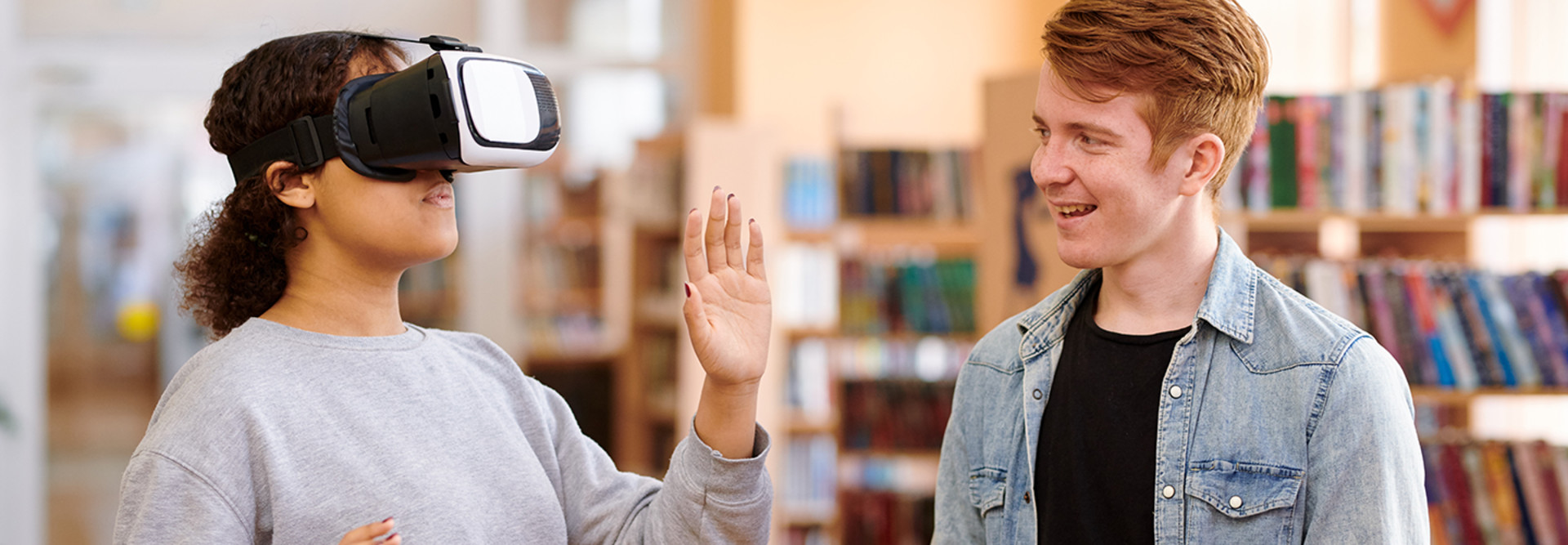Students aren’t donning headsets to participate in virtual reality lessons on most college campuses yet, and you won’t find VR on EDUCAUSE’s list of the top 10 strategic technologies institutions are expected to implement this year.
But a number of institutions have embraced VR technology in the classroom — to dissect a simulated cadaver, or travel back in time and make other educational journeys that would be difficult or impossible in real life — according to D. Christopher Brooks, EDUCAUSE’s director of research.
As the price point drops and devices improve, Brooks suspects VR use in higher education will expand.
“Our numbers show it’s very much still in the experimental phase,” he says. “We’re not seeing it in lecture halls, but it’s being used in specialized labs and other kinds of teaching venues. It’s becoming more common.”
MORE FROM EDTECH: Check out how universities are investing in VR to improve research programs.
Arizona State Uses VR in Higher Education in Online Biology Program
Arizona State University decided to adopt VR to allow remote students to participate in lab exercises in its recently launched online biological science degree program in the School of Life Sciences.
ASU used a grant to obtain 140 Mirage Solo headsets from Lenovo. Just over one third of students have elected to receive one, at no cost, since the program piloted their use in 2018.
Alternately, students can view simulations on a computer or a Google Daydream device, says Philippos Savvides. He’s a learning technology manager with EdPlus, an ASU unit focused on scaling access to education through online programs and other initiatives.
“We’ve gotten very positive feedback,” Savvides says. “They get to be active and move around using the headset and controller, so there’s an active-learning element involved. There’s a wide body of literature that shows significantly higher learning outcomes on simulations versus other modes of learning.”
Consider Physical Space and Accessibility When Planning VR Programs
VR can pose logistical challenges, some of which can be mitigated with newer standalone headsets. Headsets that connect to a computer — the more common choice for many colleges — can be limited by cord length and the physical environment.
“You tend to need a pretty high-powered PC with servers to process all these polygons making up the environment as you’re experiencing it,” Brooks says. “When these things are tethered to machines, the amount of mobility you have is somewhat constrained.”
Even without a need for much space, traditional classrooms and lecture halls with fixed seating aren’t ideal for VR use, he says.
“It’s very difficult to have students really experience virtual reality in a meaningful way if they’re not able to move around or it’s crowded and noisy,” Brooks says. “That can disrupt the experience. Schools need to rethink what a virtual reality classroom might look like.”
Device accessibility is another consideration. “That’s been overlooked somewhat,” Brooks says. “A lot of people wear corrective lenses. Designers may need to start thinking about how the devices accommodate glasses.”
For some disciplines and pedagogical objectives, VR experiences may not be readily available, says Dr. Matthew Bramlet, pediatric cardiologist and physician at OSF Children’s Hospital of Illinois, assistant professor of pediatrics at the University of Illinois College of Medicine at Peoria, and director of advanced imaging and modeling at Jump Simulation, a collaboration between the hospital and college.
“The problem a lot of institutions have getting into the VR game is the limited content that’s out there,” Bramlet says. “In medicine, there are some fantastic VR modules that are specific to how to put a central line in or hammer a nail into a bone. That solves .0001 percent of the curriculum.”
To address that, U of I’s medical college developed its own content. Approximately 40 faculty members have created more than 250 VR lectures. The college provides access to Enduvo, a VR authoring tool Bramlet helped create, and lab space, featuring ceiling-mounted workstations equipped with HTC VIVE headsets powered by a variety of Dell, HP and other computers.
The VR exercises that faculty devised for medical students may ask them, for example, to identify a specific artery on a 3D model.
“We didn’t want to write traditional questions,” Bramlet says. “We wanted [students to perform] more of a task.”
MORE FROM EDTECH: See these four ways colleges are embracing virtual reality.
VR Experiences Elevate the Transfer of Knowledge
Alice Butzlaff, an assistant professor with The Valley Foundation School of Nursing at San Jose State University, created original teaching exercises through a program sponsored by eCampus, a university resource that offers design and training assistance to help faculty integrate AR/VR technology, including workshops and demos of its HTC VIVE, Samsung Gear VR and other equipment.
Most of Butzlaff’s students said the technology enhanced their learning experience.
“It uses your hearing and visualization senses,” she says. “You can actually reach out and touch things — it was really entertaining for them.”
While VR usage is still on the upswing, Bramlet sees potential for the technology to help instructors deliver crucial information in a more effective, efficient manner than in the past.
“We go through a ton of production to create the best 2D video we can, but it’s so impersonal,” Bramlet says. “The 2D format was terrible for the transfer of knowledge — this is the missing link in that process.
We’re able to achieve a lot of interaction that we couldn’t in other digital media formats. You teach to the individual.”










